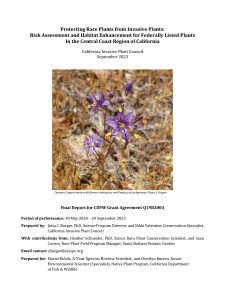
This report analyzes the risk of impacts from invasive plants to more than seven hundred populations of fifty federally listed plant species in the central coast of California. Results include population-, species-, and geographically-based invasive plant risk scores that land managers can use to prioritize invasive plant management for the purpose of rare plant protection.
The report also includes a summary of a detailed, four-year field study of invasive plant associations, local demographic patterns, and seed resources of three target listed plants: Pismo Clarkia, Gaviota tarplant, and Camatta Canyon amole.
Download the Report
Contents:
Executive Summary
Task 1. Project Management and Administration
Task 2. Complete an Invasive Plant Risk Index
Task 3. Update Population Status Information for Three Federally Listed Plants: Pismo Clarkia, Camatta Canyon Amole, and Gaviota tarplant
Task 4. Make Conservation Seed and Tissue Collections
Conclusions
Literature Cited
Appendices
Please cite this report as: California Invasive Plant Council and Santa Barbara Botanic Garden. 2023. Protecting Rare Plants from Invasive Plants: Risk Assessment and Habitat Assessment for Federally Listed Plants in the Central Coast Region of California. Cal-IPC Publication 2023-01. California Invasive Plant Council, Berkeley, CA. Available at www.cal-ipc.org.
For more information, contact Cal-IPC.
